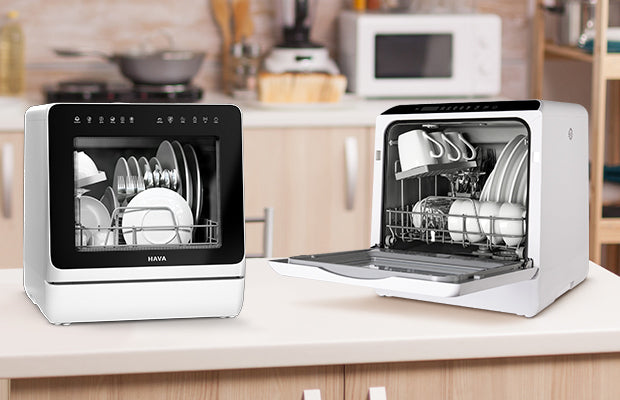Dishwashers make washing the dishes easy while keeping the kitchen organized. However, it develops issues like not draining properly. While this can be frustrating, the dishwasher not draining is a common problem you can correct yourself with little or no professional assistance.
So, what do you do when your dishwasher does not drain properly? Read on to find out as we provide you with a step-by-step guide on fixing this problem and prevention tips to keep it draining properly.
Part 1. What to Do When Your Dishwasher Won't Drain?
You open your dishwasher to do some dishes and notice standing water. Well, you have no reason to fret. Here is how to fix the dishwasher not draining completely. But first, disconnect your dishwasher from the power supply by unplugging it or turning off its circuit breaker. Afterward, follow these simple steps below.

1. Check for a Blockage
Your dishwasher might not be draining due to blockage caused by items or pieces of food that might have fallen from the rack. So when your dishwasher isn't draining properly, the first thing to do is check its bottom to ensure no items obstruct the water flow.
2. Get Rid Of Standing Water
One way you know your dishwasher is not draining properly is the presence of standing water after completing a wash cycle. The presence of this water would also prevent you from properly checking for mishaps within the dishwasher. So what do you do? Get an absorbent towel and mop up the standing water to get a better view of the dishwasher's interior.

3. Remove Debris From The Filter
Your dishwasher not draining completely could be a result of a clogged filter. Most homeowners do not know that dishwasher filters require maintenance. Maintenance implies regular cleaning. If you are unsure how to clean your filter, it is best to consult your owner's manual for steps on how to do this.

4. Assess The Drain Hose
The drain (plumbing) hose is that part of the dishwasher connecting the sink and garbage disposal. The dishwasher not draining water properly could result from a kink or clog in the hose. To solve this, you only need to straighten any kink you find on the hose or pass a wire hanger through it to clear the clog.
5. Check The Garbage Disposal
Is your dishwasher not draining properly after trying out the above? Then the problem might be from your garbage disposal. A blocked garbage disposal would cause water not to drain properly.
To unclog the garbage disposal, run it for about half a minute.
6. Clean The Air Gap
The air gap (plumbing) is that part of a dishwasher that looks like a raised knob, you'd usually find it next to your sink faucet. Grime build-up in the air gap could cause your dishwasher not to drain properly. All you need to do is remove the grime build-up using an old toothbrush or a tweezer, then pop the knob back into its place. Also, keep in mind that not all dishwashers feature an air gap.
7. Make Sure The Dishwasher Door Latch Is Closed
The dishwasher door latch not closing properly could also cause improper drainage. Most times, a latch not closing results from incorrect dishwasher loading, which is why it is best to read the owner's manual on how to load the dishwasher correctly.
8. Check The Drain Valve
The drain valve is often located at the bottom of the machine, found on the valve bracket. If the valve is stuck, water will not drain properly. So push on the valve to make sure it is moving freely.
Part 2. How to Keep Your Dishwasher Draining Properly?
Having examined what to do when your dishwasher is not draining properly, let's discuss how to keep it draining properly. Here are some things to do regularly to ensure clogging does not occur.

1. Turn on Your Garbage Disposal
Most dishwashers come connected to the garbage disposal. A blocked garbage disposal would cause your dishwasher not to drain properly. So to keep your dishwasher in optimal condition, it is best to run the garbage disposal regularly for about 1 minute. The aim is to clear out debris and leftover food.
2. Don't Use Drain Cleaner In The Dishwasher
It is advisable to avoid using drain cleaning agents in your dishwasher. The primary reason is this; drain cleaning agents contain toxic ingredients and often leave residues after unclogging your drain. These toxic residues could be transferred to your dishes when you next use the dishwasher, which could harm your health. Asides from its health challenges, drain cleaners could damage your dishwasher's rubber, thus creating leaks in several places.
3. Make Sure You're Using The Right Type Of Dishwashing Detergent
We cannot understate the importance of using the right dishwashing detergent on your dishwasher. Using conventional liquid sink soaps could cause your dishwasher not to drain properly since it produces too many suds and bubbles. When running your dishwasher, it is best to always use the right detergent as they are often suds-less and would not interfere with drainage.
4. Perform Annual Maintenance On Your Dishwasher
It is important to always remember that your dishwasher is a machine. As you should know, every machine requires regular maintenance. Maintenance ranges from checking the filter, hose, garbage disposal, and air gap regularly to contracting the services of a pro for diagnostic help and repairs.
While discussing challenges you might experience using a dishwasher, it is also important to note that not all dishwashers come with challenges.
The HAVA countertop dishwasher, one of the Amazon best sellers in 2021, is one such problem-free dishwasher. This dishwasher, while compact, has a large capacity with two place settings, ideal for use in a Kitchen, RV, or boat. It features 5 wash cycles and a dry mode, ensuring it thoroughly cleans your dishes regardless of the nature of the dirt. The HAVA countertop dishwasher comes with 360 degrees cleaning, which guarantees your dishes come out of the dishwasher spotless.
Other features that make the HAVA countertop dishwasher stand out are its 75% reduced water consumption rate and 2 water supply modes. By two water supply modes, we mean that with this dishwasher, you can connect directly to the faucet or use water stored in its built-in 5L tank.

Pros
- Fast washing cycle
- Consumes 25% of water
- Portable design
- Five-liter built-in water tank
- Does not require a plumbing fixture
- Washes dishes thoroughly
Cons
- It does not dry fast, as drying sometimes takes an hour.
Conclusion
The dishwasher not draining is a common problem with most models. However, you need not fret much, as it is a challenge you can solve easily with little or no professional assistance. All you need to do most times is clear out water from the dishwasher, check the filter and hose, as well as run the garbage disposal.
Haven't gotten a dishwasher yet, or looking to change yours? Then choose the HAVA countertop dishwasher, which offers many benefits from alternative water sources, fast washing, to zero plumbing.















